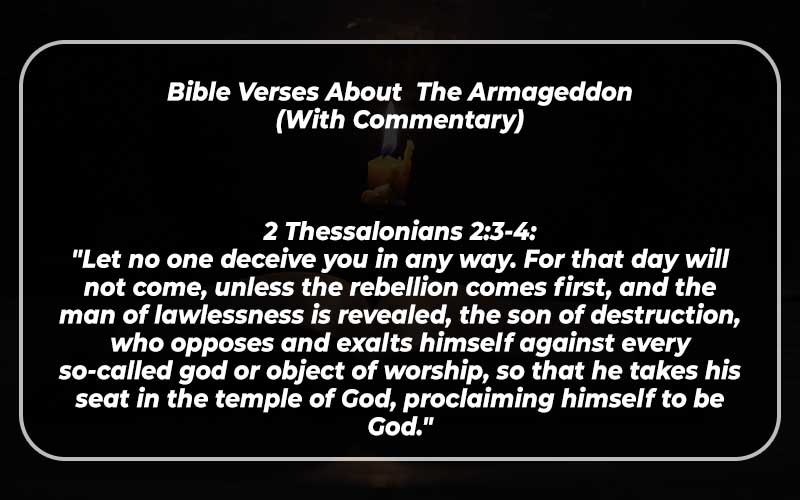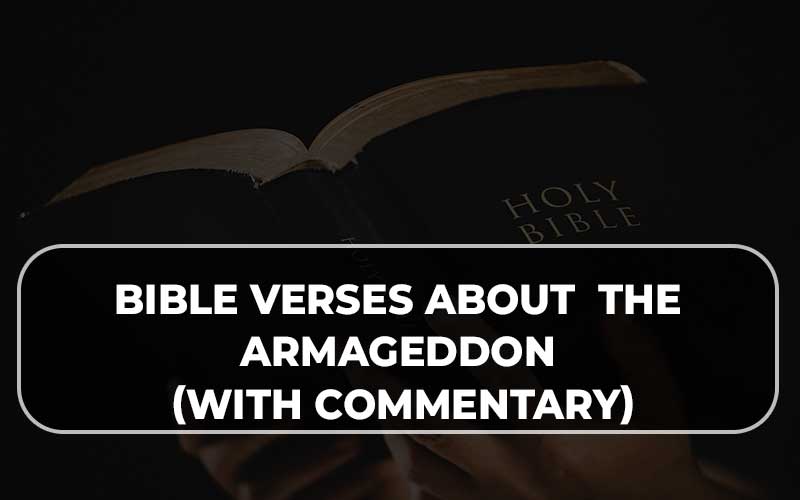Revelation 16:16: “And they assembled them at the place that in Hebrew is called Armageddon.”
The mention of Armageddon is found in the context of the gathering of forces for a final battle. The term is often associated with the end times and the ultimate conflict between good and evil.
Bible Verses About The Armageddon
Revelation 19:19-21: “And I saw the beast and the kings of the earth with their armies gathered to make war against him who was sitting on the horse and against his army. And the beast was captured, and with it the false prophet who in its presence had done the signs by which he deceived those who had received the mark of the beast and those who worshiped its image. These two were thrown alive into the lake of fire that burns with sulfur. And the rest were slain by the sword that came from the mouth of him who was sitting on the horse, and all the birds were gorged with their flesh.”
This passage describes the climactic battle at Armageddon, portraying the defeat of the beast, the false prophet, and their followers by the victorious forces led by the one sitting on the horse.
Joel 3:12-14: “Let the nations stir themselves up and come up to the Valley of Jehoshaphat; for there I will sit to judge all the surrounding nations. Put in the sickle, for the harvest is ripe. Go in, tread, for the winepress is full. The vats overflow, for their evil is great. Multitudes, multitudes, in the valley of decision! For the day of the Lord is near in the valley of decision.”
Joel’s prophecy references a valley associated with judgment, often linked with the concept of Armageddon. The imagery of harvest and the day of the Lord underscores the finality and significance of the events.
Zechariah 12:3-4: “On that day I will make Jerusalem a heavy stone for all the peoples. All who lift it will surely hurt themselves. And all the nations of the earth will gather against it. On that day, declares the Lord, I will strike every horse with panic, and its rider with madness. But for the sake of the house of Judah I will keep my eyes open, when I strike every horse of the peoples with blindness.”
The mention of nations gathering against Jerusalem and divine intervention highlights the apocalyptic nature of the events leading up to the ultimate conflict associated with Armageddon.
Matthew 24:21-22: “For then there will be great tribulation, such as has not been from the beginning of the world until now, no, and never will be. And if those days had not been cut short, no human being would be saved. But for the sake of the elect, those days will be cut short.”
Jesus speaks of a time of unprecedented tribulation, indicating the severity of the events leading up to the culmination of human history. The intervention for the sake of the elect suggests divine mercy amid the chaos.
Daniel 11:45: “And he shall pitch his palatial tents between the sea and the glorious holy mountain. Yet he shall come to his end, with none to help him.”
This verse is often associated with end-time events and the positioning of a figure whose end is foretold. The reference to the holy mountain may link to the biblical themes surrounding Jerusalem and Armageddon.
Daniel 12:1: “At that time shall arise Michael, the great prince who has charge of your people. And there shall be a time of trouble, such as never has been since there was a nation till that time. But at that time your people shall be delivered, everyone whose name shall be found written in the book.”
Daniel’s prophecy speaks of a time of unprecedented trouble, yet the reassurance is given that the people of God will be delivered, aligning with themes associated with the end times.
Matthew 24:29-31: “Immediately after the tribulation of those days the sun will be darkened, and the moon will not give its light, and the stars will fall from heaven, and the powers of the heavens will be shaken. Then will appear in heaven the sign of the Son of Man, and then all the tribes of the earth will mourn, and they will see the Son of Man coming on the clouds of heaven with power and great glory. And he will send out his angels with a loud trumpet call, and they will gather his elect from the four winds, from one end of heaven to the other.”
Jesus describes cosmic signs and the visible return of the Son of Man, accompanied by the gathering of the elect. These events are often associated with the culmination of history and the events leading to Armageddon.
2 Thessalonians 2:3-4: “Let no one deceive you in any way. For that day will not come, unless the rebellion comes first, and the man of lawlessness is revealed, the son of destruction, who opposes and exalts himself against every so-called god or object of worship, so that he takes his seat in the temple of God, proclaiming himself to be God.”
This passage refers to a figure known as the man of lawlessness who exalts himself against God. The connection to the temple of God and the assertion of deity aligns with themes associated with the end times and Armageddon.

Revelation 14:14-20: “Then I looked, and behold, a white cloud, and seated on the cloud one like a son of man, with a golden crown on his head, and a sharp sickle in his hand. And another angel came out of the temple, calling with a loud voice to him who sat on the cloud, ‘Put in your sickle, and reap, for the hour to reap has come, for the harvest of the earth is fully ripe.'”
This passage portrays a scene of divine reaping and judgment, with the imagery of a sharp sickle and the ripe harvest suggesting the culmination of God’s redemptive plan and the final separation of the righteous and the wicked.
Revelation 20:7-9: “And when the thousand years are ended, Satan will be released from his prison and will come out to deceive the nations that are at the four corners of the earth, Gog and Magog, to gather them for battle; their number is like the sand of the sea. And they marched up over the broad plain of the earth and surrounded the camp of the saints and the beloved city, but fire came down from heaven and consumed them.”
This passage describes a post-millennial rebellion led by Satan, culminating in a battle against the saints and the beloved city. The divine intervention with fire emphasizes God’s sovereignty over the forces of evil.
Revelation 16:12-16: “The sixth angel poured out his bowl on the great river Euphrates, and its water was dried up, to prepare the way for the kings from the east. And I saw, coming out of the mouth of the dragon and out of the mouth of the beast and out of the mouth of the false prophet, three unclean spirits like frogs.”
The drying up of the Euphrates and the emergence of unclean spirits are described in the context of the preparation for the kings from the east, contributing to the apocalyptic imagery associated with Armageddon.
Revelation 19:11-16: “Then I saw heaven opened, and behold, a white horse! The one sitting on it is called Faithful and True, and in righteousness, he judges and makes war. His eyes are like a flame of fire, and on his head are many diadems, and he has a name written that no one knows but himself.”
The imagery of a rider on a white horse, identified as Faithful and True, underscores the theme of divine justice and the authoritative role in judging and making war, aligning with the events surrounding Armageddon.
Revelation 17:14: “They will make war on the Lamb, and the Lamb will conquer them, for he is Lord of lords and King of kings, and those with him are called and chosen and faithful.”
The reference to the Lamb making war and conquering emphasizes the ultimate victory of Christ, who is Lord of lords and King of kings. The inclusion of the called, chosen, and faithful associates with the redeemed who are aligned with Christ in the conflict.
Revelation 20:10: “And the devil who had deceived them was thrown into the lake of fire and sulfur where the beast and the false prophet were, and they will be tormented day and night forever and ever.”
Also Read: Bible Verses About Fathers Love (With Commentary)
